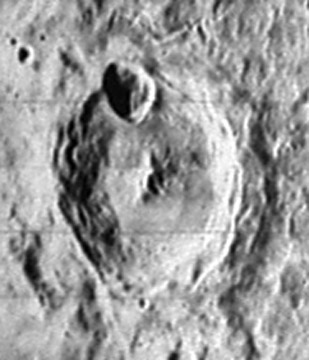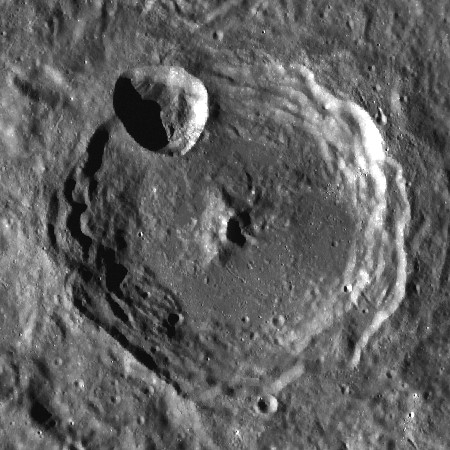Difference between revisions of "Hahn"
| (One intermediate revision by the same user not shown) | |||
| Line 6: | Line 6: | ||
|} | |} | ||
<div id="toc"> | <div id="toc"> | ||
| − | + | [[Image:Hahn-LOIV-165-H2.jpg|external image Hahn-LOIV-165-H2.jpg]][[Image:Hahn.jpg|Hahn.jpg]]<br /> ''left: [http://lpod.org/coppermine/displayimage.php?pos=-254 LOIV-165-h2] . right: '''LROC''' .'' Prominent ''s''atellite '''F''' rests at NW rim; there are several pools of melt at west and north sectors of the crater´s floor.<br /> <br /> | |
| − | |||
==Images== | ==Images== | ||
[http://www.lpod.org/coppermine/thumbnails.php?album=search&type=full&search=Hahn LPOD Photo Gallery] [http://www.lpi.usra.edu/resources/lunar_orbiter/bin/srch_nam.shtml?Hahn%7C0 Lunar Orbiter Images] [http://www.lpi.usra.edu/resources/apollo/search/feature/?feature=Hahn Apollo Images]<br /> <br /> | [http://www.lpod.org/coppermine/thumbnails.php?album=search&type=full&search=Hahn LPOD Photo Gallery] [http://www.lpi.usra.edu/resources/lunar_orbiter/bin/srch_nam.shtml?Hahn%7C0 Lunar Orbiter Images] [http://www.lpi.usra.edu/resources/apollo/search/feature/?feature=Hahn Apollo Images]<br /> <br /> | ||
| Line 15: | Line 14: | ||
<br /> | <br /> | ||
==Description: Elger== | ==Description: Elger== | ||
| − | ''([http://the-moon.us/wiki/IAU% | + | ''([http://the-moon.us/wiki/IAU%20directions IAU Directions])'' HAHN.--A ring-plain, 46 miles in diameter, with a fine central mountain and lofty peaks on the border, which is not continuous on the S. There is a large and prominent crater on the W.<br /> <br /> |
==Description: Wikipedia== | ==Description: Wikipedia== | ||
[http://en.wikipedia.org/wiki/Hahn_(crater) Hahn]<br /> <br /> | [http://en.wikipedia.org/wiki/Hahn_(crater) Hahn]<br /> <br /> | ||
==Additional Information== | ==Additional Information== | ||
| − | * Depth data from [http://the-moon.us/wiki/Kurt%20Fisher% | + | * Depth data from [http://the-moon.us/wiki/Kurt%20Fisher%20Crater%20Depths Kurt Fisher database] |
** Westfall, 2000: 4.39 km | ** Westfall, 2000: 4.39 km | ||
** Cherrington, 1969: 3.1 km | ** Cherrington, 1969: 3.1 km | ||
| Line 34: | Line 33: | ||
* According to ''[http://the-moon.us/wiki/Whitaker Whitaker]'' (p. 219), the naming of it for the first Hahn was introduced by [http://the-moon.us/wiki/M%C3%A4dler Mädler]. | * According to ''[http://the-moon.us/wiki/Whitaker Whitaker]'' (p. 219), the naming of it for the first Hahn was introduced by [http://the-moon.us/wiki/M%C3%A4dler Mädler]. | ||
* The co-naming for Otto Hahn was announced in [http://the-moon.us/wiki/Menzel%2C%201971 Menzel, 1971]. | * The co-naming for Otto Hahn was announced in [http://the-moon.us/wiki/Menzel%2C%201971 Menzel, 1971]. | ||
| − | * A mystery in the history of lunar nomenclature: Julius Heinrich [http://the-moon.us/wiki/Franz Franz] (1847-1913) proposed the name '''''Mare Trans Hahn''''', a name which was, according to Ewen A. Whitaker, not mentioned in Mary Blagg's ''[http://the-moon.us/wiki/Named%20Lunar%20Formations Named Lunar Formations]'' (see page 225 in Whitaker's book ''[http://the-moon.us/wiki/Mapping%20and%20Naming%20the%20Moon Mapping and Naming the Moon]'', Appendix M). Could it be, that Franz' '''''Mare Trans Hahn''''' was the dark streak across the floor of '''Hahn'''?<span class="membersnap">- | + | * A mystery in the history of lunar nomenclature: Julius Heinrich [http://the-moon.us/wiki/Franz Franz] (1847-1913) proposed the name '''''Mare Trans Hahn''''', a name which was, according to Ewen A. Whitaker, not mentioned in Mary Blagg's ''[http://the-moon.us/wiki/Named%20Lunar%20Formations Named Lunar Formations]'' (see page 225 in Whitaker's book ''[http://the-moon.us/wiki/Mapping%20and%20Naming%20the%20Moon Mapping and Naming the Moon]'', Appendix M). Could it be, that Franz' '''''Mare Trans Hahn''''' was the dark streak across the floor of '''Hahn'''?<span class="membersnap">- DannyCaes <small>Jun 23, 2008</small></span> |
<br /> | <br /> | ||
==LPOD Articles== | ==LPOD Articles== | ||
| Line 46: | Line 45: | ||
<br /> | <br /> | ||
==The mystery of the German geologist Dr. Hahn== | ==The mystery of the German geologist Dr. Hahn== | ||
| − | On page 322 of the book ''Mysterious Universe, a handbook of astronomical anomalies'' (William R. Corliss, ''The Sourcebook Project'', 1979) there's this rather large article '''''The Discovery of Organic Remains in Meteoritic Stones''''' (Francis Birgham, ''Popular Science Monthly'', 1881). According to this article, a German geologist known as '''Dr. Hahn''' and a zoologist known as '''Dr. Weinland''' investigated slices of meteoritic stones, in which they discovered traces of possible extraterrestrial lifeforms.<br /> Now, who was this '''Dr. Hahn'''? It's frustrating to see nothing about this German geologist on the web...<br /> The zoologist '''Dr. Weinland''' could have been [http://de.wikipedia.org/wiki/David_Friedrich_Weinland David Friedrich Weinland] (1829-1915).<br /> The largest part of the investigated meteoritic stones came from the celebrated great meteoric fall of '''Knyahinya''' in Hungary (June the 9th, 1866), see: [https://de.wikipedia.org/wiki/Knyahinya_(Meteorit) Knyahinya (Meteorit)].<br /> <span class="membersnap">- | + | On page 322 of the book ''Mysterious Universe, a handbook of astronomical anomalies'' (William R. Corliss, ''The Sourcebook Project'', 1979) there's this rather large article '''''The Discovery of Organic Remains in Meteoritic Stones''''' (Francis Birgham, ''Popular Science Monthly'', 1881). According to this article, a German geologist known as '''Dr. Hahn''' and a zoologist known as '''Dr. Weinland''' investigated slices of meteoritic stones, in which they discovered traces of possible extraterrestrial lifeforms.<br /> Now, who was this '''Dr. Hahn'''? It's frustrating to see nothing about this German geologist on the web...<br /> The zoologist '''Dr. Weinland''' could have been [http://de.wikipedia.org/wiki/David_Friedrich_Weinland David Friedrich Weinland] (1829-1915).<br /> The largest part of the investigated meteoritic stones came from the celebrated great meteoric fall of '''Knyahinya''' in Hungary (June the 9th, 1866), see: [https://de.wikipedia.org/wiki/Knyahinya_(Meteorit) Knyahinya (Meteorit)].<br /> <span class="membersnap">- DannyCaes <small>Jan 20, 2015</small></span><br /> |
---- | ---- | ||
| − | + | </div> | |
Latest revision as of 02:51, 16 April 2018
Contents
Hahn
|
Lat: 31.3°N, Long: 73.6°E, Diam: 84 km, Depth: 4.39 km, Rükl 16 |


left: LOIV-165-h2 . right: LROC . Prominent satellite F rests at NW rim; there are several pools of melt at west and north sectors of the crater´s floor.
Images
LPOD Photo Gallery Lunar Orbiter Images Apollo Images
Maps
(LAC zone 45A1) USGS Digital Atlas PDF
Description
Description: Elger
(IAU Directions) HAHN.--A ring-plain, 46 miles in diameter, with a fine central mountain and lofty peaks on the border, which is not continuous on the S. There is a large and prominent crater on the W.
Description: Wikipedia
Additional Information
- Depth data from Kurt Fisher database
- Westfall, 2000: 4.39 km
- Cherrington, 1969: 3.1 km
- Central peak composition: A & GNTA1 (Tompkins & Pieters, 1999)
Nomenclature
- The IAU name honors two different people:
- Friedrich II. Graf von Hahn (July 27, 1742 - October 9, 1805) was a German philosopher and astronomer. In 1793 he started the construction of a private observatory, the first in Mecklenburg, which was well equipped. He owned some of the largest mirrors made by William Herschel and precision instruments for determining the position of stars. In 1800, he discovered the central star in M57, the Ring Nebula in the constellation Lyra.
- Otto Hahn (March 8, 1879 – July 28, 1968) was a German chemist and received the 1944 Nobel Prize in Chemistry. He is considered a pioneer of radioactivity and radiochemistry, and regarded as "the father of nuclear chemistry." Hahn was also called the "founder of the atomic age" by his contemporaries.
- Johann Schröter, in 1789, used Riccioli's name Plutarchfor this crater.
- According to Whitaker (p. 219), the naming of it for the first Hahn was introduced by Mädler.
- The co-naming for Otto Hahn was announced in Menzel, 1971.
- A mystery in the history of lunar nomenclature: Julius Heinrich Franz (1847-1913) proposed the name Mare Trans Hahn, a name which was, according to Ewen A. Whitaker, not mentioned in Mary Blagg's Named Lunar Formations (see page 225 in Whitaker's book Mapping and Naming the Moon, Appendix M). Could it be, that Franz' Mare Trans Hahn was the dark streak across the floor of Hahn?- DannyCaes Jun 23, 2008
LPOD Articles
Bibliography
Friedrich II. Graf von Hahn in the Sourcebook Project (William R. Corliss)
- Page 97 in: Mysterious Universe, a handbook of astronomical anomalies (1979) :
- On the Visibility of the Dark Side of Venus (A. Schafarik, Report of the British Association, 1873).
The mystery of the German geologist Dr. Hahn
On page 322 of the book Mysterious Universe, a handbook of astronomical anomalies (William R. Corliss, The Sourcebook Project, 1979) there's this rather large article The Discovery of Organic Remains in Meteoritic Stones (Francis Birgham, Popular Science Monthly, 1881). According to this article, a German geologist known as Dr. Hahn and a zoologist known as Dr. Weinland investigated slices of meteoritic stones, in which they discovered traces of possible extraterrestrial lifeforms.
Now, who was this Dr. Hahn? It's frustrating to see nothing about this German geologist on the web...
The zoologist Dr. Weinland could have been David Friedrich Weinland (1829-1915).
The largest part of the investigated meteoritic stones came from the celebrated great meteoric fall of Knyahinya in Hungary (June the 9th, 1866), see: Knyahinya (Meteorit).
- DannyCaes Jan 20, 2015